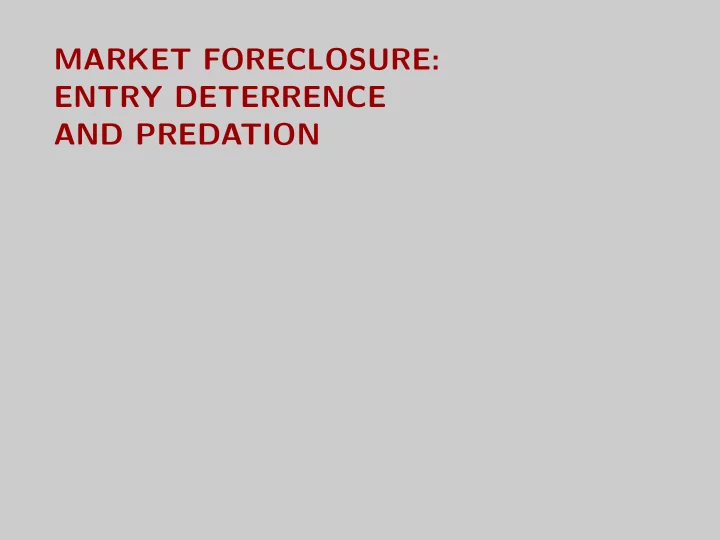

MARKET FORECLOSURE: ENTRY DETERRENCE AND PREDATION
Overview • Context: How can you discourage rivals from entering a market you are in or plan to enter? If you’re the entrant, how can you get past the incumbent’s defenses? • Concepts: commitment, cheap talk, entry deterrence, preemption • Economic principle: sometimes, lack of flexibility is more valuable than flexibility
Commitment • For many decisions, it’s useful to have lots of options • In games, it’s sometimes useful to have fewer options: to eliminate moves that lead to unattractive equilibria • We refer to this limitation of your options as commitment (as in, you’re committed to a particular course of action)
Dupont and titanium dioxide • TiO 2 : white chemical pigment employed in the manufacture of paint, etc. • Primary raw material: ilmenite ore (DuPont) or rutile ore (six smaller rivals) • Sharp increase in rutile ore price (1970): DuPont cost advantage up to 44% from 22%; also, ilmenite better compliant with stricter environmental regulation • Window of opportunity: expand capacity faster than demand, discourage expansion (or entry) by rival firms • Goal: increase DuPont’s market share from 30% in 1972 to 56% in 1980 and perhaps 65% in 1985 • Market share did increase; by 1985, five domestic competitors had exited Ghemawat, Pankaj (1984), “Capacity Expansion in the Titanium Dioxide Industry,” Journal of Industrial Economics 33 , 145–163; Hall, Elizabeth A (1990), “An Analysis of Preemptive Behavior in the Titanium Dioxide Industry,” International Journal of Industrial Organization 8 , 469–484.
Incumbent-entrant capacity game • Incumbent chooses capacity • Entrant observes incumbent’s choice and chooses capacity (0 = no entry). If entry, pay cost F Entrant 0 24 26 28 0 768 780 784 40 1920 960 880 800 0 672 676 672 44 Incumbent 1936 880 792 704 0 576 572 560 48 1920 768 672 576 Demand curve: Q = 100 − p . Capacity costs: c 1 = 12, c 2 = 4.
Case 0: no entrant 40 1920 44 1936 Incumbent 48 1920 • If there is no entrant, incumbent’s best choice is 44 • Denote this as monopoly capacity
Case 1: F = 500 Entrant 0 24 26 28 0 268 280 284 40 1920 960 880 800 0 172 176 172 44 Incumbent 1936 880 792 704 0 76 72 60 48 1920 768 672 576 • Given Entrant’s strategy, Incumbent is better off by choosing 40 • We call this a strategy of entry accommodation
Case 2: F = 600 Entrant 0 24 26 28 0 168 180 184 40 1920 960 880 800 0 72 76 72 44 Incumbent 1936 880 792 704 0 -24 -28 -40 48 1920 768 672 576 • Given Entrant’s strategy, Incumbent is better off by choosing 48 • We call this a strategy of entry deterrence
Case 3: F = 700 Entrant 0 24 26 28 0 68 80 84 40 1920 960 880 800 0 -28 -24 -28 44 Incumbent 1936 880 792 704 0 -124 -128 -140 48 1920 768 672 576 • Given Entrant’s strategy, Incumbent is better off by choosing 44 • We refer to this situation as blockaded entry
Incumbent-entrant capacity game • F = 500. Entrant is better off by entering. Incumbent’s optimal capacity: 40 (entry accommodation) • F = 600. Entrant stays out if and only if incumbent chooses capacity 48, which is optimal choice (entry deterrence) • F = 700. Incumbent chooses optimal monopoly capacity (44) and entrant stays out (blockaded entry) • Notice that incumbents optimal capacity is non-monotonic with respect to F : from 40 to 48, then down to 44
The miracles of science TiO 2 Capacity (000 tons) 600 rival firms DuPont 400 200 Year 0 72 73 74 75 76 77
Games hospitals play • Previous theory suggests relation between likelihood of entry and investment is non-monotonic: − Low entry probability: blockaded entry − Medium entry probability: entry deterrence − High entry probability: accommodated entry • Possible test: period after Medicare announces likely reimbursement increase but before it takes effect • Incumbent’s strategy: sales volume increase (market for electrophysiological studies, procedure to identify cardiac arrhythmias) • Measure of entry probability: # of potential entrants Dafny, Leemore (2005), “Games Hospitals Play: Entry Deterrence in Hospital Procedure Markets,” Journal of Economics and Management Strategy 14 (3), 513–542
Games hospitals play Volume increase (%) 0.5 0.4 0.3 0.2 0.1 Number of potential entrants 0.0 0 1 2 3 4 Dafny, Leemore (2005), “Games Hospitals Play: Entry Deterrence in Hospital Procedure Markets,” Journal of Economics and Management Strategy 14 (3), 513–542
Product proliferation • Example: Breakfast cereals − Highly profitable industry − Low technological barriers to entry − Same small number of incumbents for decades • Idea: increase number of varieties so as to leave no room for potential entrants
Recommend
More recommend